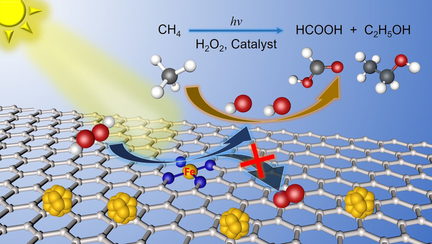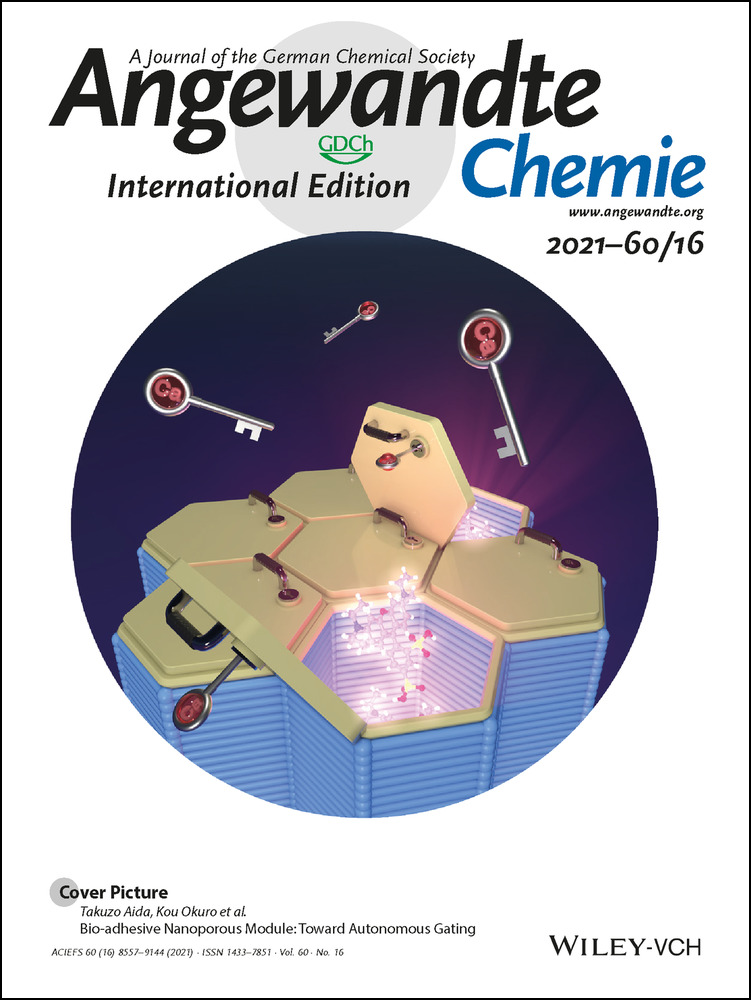Fe/Fe3C Boosts H2O2 Utilization for Methane Conversion Overwhelming O2 Generation
Yicheng Xing
State Key Laboratory of Heavy Oil Processing, Institute of New Energy, College of Chemical Engineering, China University of Petroleum (East China), Qingdao, 266580 P. R. China
Search for more papers by this authorZheng Yao
State Key Laboratory of Heavy Oil Processing, Institute of New Energy, College of Chemical Engineering, China University of Petroleum (East China), Qingdao, 266580 P. R. China
Search for more papers by this authorWenyuan Li
State Key Laboratory of Heavy Oil Processing, Institute of New Energy, College of Chemical Engineering, China University of Petroleum (East China), Qingdao, 266580 P. R. China
Search for more papers by this authorCorresponding Author
Prof. Wenting Wu
State Key Laboratory of Heavy Oil Processing, Institute of New Energy, College of Chemical Engineering, China University of Petroleum (East China), Qingdao, 266580 P. R. China
Search for more papers by this authorProf. Xiaoqing Lu
College of Materials Science and Engineering, China University of Petroleum (East China), Qingdao, 266580 P. R. China
Search for more papers by this authorProf. Jun Tian
State Key Laboratory of Molecular Engineering of Polymers and Department of Macromolecular Science, Fudan University, Shanghai, 200433 P. R. China
Search for more papers by this authorZhongtao Li
State Key Laboratory of Heavy Oil Processing, Institute of New Energy, College of Chemical Engineering, China University of Petroleum (East China), Qingdao, 266580 P. R. China
Search for more papers by this authorHan Hu
State Key Laboratory of Heavy Oil Processing, Institute of New Energy, College of Chemical Engineering, China University of Petroleum (East China), Qingdao, 266580 P. R. China
Search for more papers by this authorCorresponding Author
Prof. Mingbo Wu
State Key Laboratory of Heavy Oil Processing, Institute of New Energy, College of Chemical Engineering, China University of Petroleum (East China), Qingdao, 266580 P. R. China
Search for more papers by this authorYicheng Xing
State Key Laboratory of Heavy Oil Processing, Institute of New Energy, College of Chemical Engineering, China University of Petroleum (East China), Qingdao, 266580 P. R. China
Search for more papers by this authorZheng Yao
State Key Laboratory of Heavy Oil Processing, Institute of New Energy, College of Chemical Engineering, China University of Petroleum (East China), Qingdao, 266580 P. R. China
Search for more papers by this authorWenyuan Li
State Key Laboratory of Heavy Oil Processing, Institute of New Energy, College of Chemical Engineering, China University of Petroleum (East China), Qingdao, 266580 P. R. China
Search for more papers by this authorCorresponding Author
Prof. Wenting Wu
State Key Laboratory of Heavy Oil Processing, Institute of New Energy, College of Chemical Engineering, China University of Petroleum (East China), Qingdao, 266580 P. R. China
Search for more papers by this authorProf. Xiaoqing Lu
College of Materials Science and Engineering, China University of Petroleum (East China), Qingdao, 266580 P. R. China
Search for more papers by this authorProf. Jun Tian
State Key Laboratory of Molecular Engineering of Polymers and Department of Macromolecular Science, Fudan University, Shanghai, 200433 P. R. China
Search for more papers by this authorZhongtao Li
State Key Laboratory of Heavy Oil Processing, Institute of New Energy, College of Chemical Engineering, China University of Petroleum (East China), Qingdao, 266580 P. R. China
Search for more papers by this authorHan Hu
State Key Laboratory of Heavy Oil Processing, Institute of New Energy, College of Chemical Engineering, China University of Petroleum (East China), Qingdao, 266580 P. R. China
Search for more papers by this authorCorresponding Author
Prof. Mingbo Wu
State Key Laboratory of Heavy Oil Processing, Institute of New Energy, College of Chemical Engineering, China University of Petroleum (East China), Qingdao, 266580 P. R. China
Search for more papers by this authorGraphical Abstract
Abstract
H2O2 as a well-known efficient oxidant is widely used in the chemical industry mainly because of its homolytic cleavage into .OH (stronger oxidant), but this reaction always competes with O2 generation resulting in H2O2 waste. Here, we fabricate heterogeneous Fenton-type Fe-based catalysts containing Fe-Nx sites and Fe/Fe3C nanoparticles as a model to study this competition. Fe-Nx in the low spin state provides the active site for .OH generation. Fe/Fe3C, in particular Fe3C, promotes Fe-Nx sites for the homolytic cleavages of H2O2 into .OH, but Fe/Fe3C nanoparticles (Fe0 as the main component) with more electrons are prone to the undesired O2 generation. With a catalyst benefiting from finely tuned active sites, 18 % conversion rate for the selective oxidation of methane was achieved with about 96 % selectivity for liquid oxygenates (formic acid selectivity over 90 %). Importantly, O2 generation was suppressed 68 %. This work provides guidance for the efficient utilization of H2O2 in the chemical industry.
Conflict of interest
The authors declare no conflict of interest.
Supporting Information
As a service to our authors and readers, this journal provides supporting information supplied by the authors. Such materials are peer reviewed and may be re-organized for online delivery, but are not copy-edited or typeset. Technical support issues arising from supporting information (other than missing files) should be addressed to the authors.
| Filename | Description |
|---|---|
| anie202016888-sup-0001-misc_information.pdf1.2 MB | Supplementary |
| anie202016888-sup-0001-Video_S1.mov19.1 MB | Supplementary |
| anie202016888-sup-0001-Video_S2.mov19.1 MB | Supplementary |
| anie202016888-sup-0001-Video_S3.mov18.9 MB | Supplementary |
Please note: The publisher is not responsible for the content or functionality of any supporting information supplied by the authors. Any queries (other than missing content) should be directed to the corresponding author for the article.
References
- 1
- 1aK. Sato, M. Aoki, R. Noyori, Science 1998, 281, 1646;
- 1bD. Deng, X. Chen, L. Yu, X. Wu, Q. Liu, Y. Liu, H. Yang, H. Tian, Y. Hu, P. Du, R. Si, J. Wang, X. Cui, H. Li, J. Xiao, T. Xu, J. Deng, F. Yang, P. N. Duchesne, P. Zhang, J. Zhou, L. Sun, J. Li, X. Pan, X. Bao, Sci. Adv. 2015, 1, e1500462;
- 1cY. Pan, Y. Chen, K. Wu, Z. Chen, S. Liu, X. Cao, W.-C. Cheong, T. Meng, J. Luo, L. Zheng, C. Liu, D. Wang, Q. Peng, J. Li, C. Chen, Nat. Commun. 2019, 10, 4290;
- 1dH. Hou, X. Zeng, X. Zhang, Angew. Chem. Int. Ed. 2020, 59, 17356–17376; Angew. Chem. 2020, 132, 17508–17529;
- 1eA. Maldotti, C. Bartocci, R. Amadelli, E. Polo, P. Battioni, D. Mansuy, J. Chem. Soc. Chem. Commun. 1991, 1487–1489;
- 1fE.-Y. Jeong, M. B. Ansari, S.-E. Park, ACS Catal. 2011, 1, 855–863.
- 2
- 2aL. Shi, L. Yang, H. Zhang, K. Chang, G. Zhao, T. Kako, J. Ye, Appl. Catal. B 2018, 224, 60–68;
- 2bL. Wang, P. Jin, S. Duan, J. Huang, H. She, Q. Wang, T. An, Environ. Sci. Nano 2019, 6, 2652–2661.
- 3
- 3aP. Schwach, X. Pan, X. Bao, Chem. Rev. 2017, 117, 8497–8520;
- 3bE. McFarland, Science 2012, 338, 340.
- 4
- 4aM. Ravi, M. Ranocchiari, J. A. van Bokhoven, Angew. Chem. Int. Ed. 2017, 56, 16464–16483; Angew. Chem. 2017, 129, 16684–16704;
- 4bP. Tang, Q. Zhu, Z. Wu, D. Ma, Energy Environ. Sci. 2014, 7, 2580–2591.
- 5
- 5aJ. H. Lunsford, Angew. Chem. Int. Ed. Engl. 1995, 34, 970–980; Angew. Chem. 1995, 107, 1059–1070;
- 5bC.-G. Zhan, J. A. Nichols, D. A. Dixon, J. Phys. Chem. A 2003, 107, 4184–4195;
- 5cR. D. Amos, Mol. Phys. 1979, 38, 33–45.
- 6M. Ahlquist, R. J. Nielsen, R. A. Periana, W. A. Goddard III, J. Am. Chem. Soc. 2009, 131, 17110–17115.
- 7N. Agarwal, S. J. Freakley, R. U. McVicker, S. M. Althahban, N. Dimitratos, Q. He, D. J. Morgan, R. L. Jenkins, D. J. Willock, S. H. Taylor, C. J. Kiely, G. J. Hutchings, Science 2017, 358, 223.
- 8X. Cui, H. Li, Y. Wang, Y. Hu, L. Hua, H. Li, X. Han, Q. Liu, F. Yang, L. He, X. Chen, Q. Li, J. Xiao, D. Deng, X. Bao, Chem 2018, 4, 1902–1910.
- 9J. Deng, D. Deng, X. Bao, Adv. Mater. 2017, 29, 1606967.
- 10A. Serov, K. Artyushkova, P. Atanassov, Adv. Energy Mater. 2014, 4, 1301735.
- 11R. Cao, R. Thapa, H. Kim, X. Xu, M. G. Kim, Q. Li, N. Park, M. Liu, J. Cho, Nat. Commun. 2013, 4, 2076.
- 12J. Liu, E. Li, M. Ruan, P. Song, W. J. C. Xu, Catalysts 2015, 5, 1167–1192.
- 13G. Wu, K. L. More, C. M. Johnston, P. Zelenay, Science 2011, 332, 443.
- 14U. I. Kramm, L. Ni, S. Wagner, Adv. Mater. 2019, 31, 1805623.
- 15J. Li, S. Ghoshal, W. Liang, M.-T. Sougrati, F. Jaouen, B. Halevi, S. McKinney, G. McCool, C. Ma, X. Yuan, Z.-F. Ma, S. Mukerjee, Q. Jia, Energy Environ. Sci. 2016, 9, 2418–2432.
- 16U. I. Koslowski, I. Abs-Wurmbach, S. Fiechter, P. Bogdanoff, J. Phys. Chem. C 2008, 112, 15356–15366.
- 17
- 17aJ. Xie, R. Jin, A. Li, Y. Bi, Q. Ruan, Y. Deng, Y. Zhang, S. Yao, G. Sankar, D. Ma, J. Tang, Nat. Catal. 2018, 1, 889–896;
- 17bY. Kwon, T. Y. Kim, G. Kwon, J. Yi, H. Lee, J. Am. Chem. Soc. 2017, 139, 17694–17699;
- 17cQ. Shen, C. Cao, R. Huang, L. Zhu, X. Zhou, Q. Zhang, L. Gu, W. Song, Angew. Chem. Int. Ed. 2020, 59, 1216–1219; Angew. Chem. 2020, 132, 1232–1235.
- 18
- 18aR. S. Hargrove, W. Kündig, Solid State Commun. 1970, 8, 303–308;
- 18bF. J. Berry, S. Skinner, M. F. Thomas, J. Phys. Condens. Matter 1998, 10, 215–220.
- 19
- 19aY. Nosaka, A. Y. Nosaka, Chem. Rev. 2017, 117, 11302–11336;
- 19bM. C. DeRosa, R. J. Crutchley, Coord. Chem. Rev. 2002, 233–234, 351–371.
- 20J. D. Rush, W. H. Koppenol, J. Biol. Chem. 1986, 261, 6730–6733.
- 21M. Hayyan, M. A. Hashim, I. M. AlNashef, Chem. Rev. 2016, 116, 3029–3085.
- 22Q. Xiang, J. Yu, P. K. Wong, J. Colloid Interface Sci. 2011, 357, 163–167.
- 23D. Dvoranová, Z. Barbieriková, V. J. M. Brezová, Molecules 2014, 19, 17279–17304.
- 24
- 24aW.-J. Jiang, L. Gu, L. Li, Y. Zhang, X. Zhang, L.-J. Zhang, J.-Q. Wang, J.-S. Hu, Z. Wei, L.-J. Wan, J. Am. Chem. Soc. 2016, 138, 3570–3578;
- 24bX. Ao, W. Zhang, Z. Li, J.-G. Li, L. Soule, X. Huang, W.-H. Chiang, H. M. Chen, C. Wang, M. Liu, X. C. Zeng, ACS Nano 2019, 13, 11853–11862.
- 25Q. Wang, Z.-Y. Zhou, Y.-J. Lai, Y. You, J.-G. Liu, X.-L. Wu, E. Terefe, C. Chen, L. Song, M. Rauf, N. Tian, S.-G. Sun, J. Am. Chem. Soc. 2014, 136, 10882–10885.
- 26
- 26aJ. Chen, A. Draksharapu, D. Angelone, D. Unjaroen, S. K. Padamati, R. Hage, M. Swart, C. Duboc, W. R. Browne, ACS Catal. 2018, 8, 9665–9674;
- 26bK. Cheaib, M. Q. E. Mubarak, K. Sénéchal-David, C. Herrero, R. Guillot, M. Clémancey, J.-M. Latour, S. P. de Visser, J.-P. Mahy, F. Banse, F. Avenier, Angew. Chem. Int. Ed. 2019, 58, 854–858; Angew. Chem. 2019, 131, 864–868.
- 27
- 27aW. P. Kwan, B. M. Voelker, Environ. Sci. Technol. 2002, 36, 1467–1476;
- 27bG. C. Taylor, R. J. Waddington, R. Moseley, K. R. Williams, G. Embery, Biomaterials 1996, 17, 1313–1319;
- 27cD. W. McKee, J. Catal. 1969, 14, 355–364.
- 28M. H. Ab Rahim, M. M. Forde, R. L. Jenkins, C. Hammond, Q. He, N. Dimitratos, J. A. Lopez-Sanchez, A. F. Carley, S. H. Taylor, D. J. Willock, D. M. Murphy, C. J. Kiely, G. J. Hutchings, Angew. Chem. Int. Ed. 2013, 52, 1280–1284; Angew. Chem. 2013, 125, 1318–1322.
- 29Y. Zhou, L. Zhang, W. Wang, Nat. Commun. 2019, 10, 506.
- 30S. Gligorovski, R. Strekowski, S. Barbati, D. Vione, Chem. Rev. 2015, 115, 13051–13092.
- 31Q. Xing, Basic Organic Chemistry, Vol. 4, 4th ed., Peking University Press, Peking, 2016, pp. 113–135.





